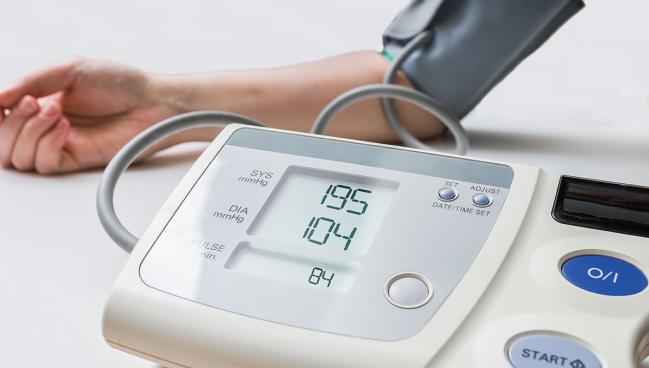SPYRAL HTN-ON MED Trial of Renal Denervation Misses Primary Endpoint
Though “problematic,” it doesn’t derail the positive story around the procedure, Sidney Smith says. But more work is needed.

CHICAGO, IL—In the expanded SPYRAL HTN-ON MED trial, renal denervation with the Symplicity Spyral multielectrode catheter (Medtronic) failed to meet its primary endpoint in terms of blood pressure-lowering compared with a sham procedure in patients taking antihypertensive medications, researchers report.
The average reduction in 24-hour systolic BP in the denervation arm (6.5 mm Hg by 6 months), was in line with recent sham-controlled trials that met their primary endpoints. However, that was not significantly greater than the 4.5-mm Hg reduction seen in the sham arm (P = 0.12). And in the primary Bayesian analysis, there was only a 51% probability of renal denervation being superior, far below the threshold for success (97.5%).
But David Kandzari, MD (Piedmont Heart Institute, Atlanta, GA), who presented the findings here at the American Heart Association 2022 Scientific Sessions, highlighted issues related to changes brought on by the COVID-19 pandemic—which temporarily stalled the trial—and to a disproportionate amount of medication changes in the sham arm, despite a protocol mandate against doing so, to explain the result.
In particular, by 3 months, urine and blood testing confirmed that both the average number of drugs taken and the overall medication burden increased in the sham arm, with separation between the two groups. Thus, that may have diluted any difference in BP-lowering between the denervation and sham arms, Kandzari said.
Pointing to the fact that both 24-hour ambulatory and office BP reductions in the denervation arm are consistent with prior trials—including the SPYRAL HTN-ON MED pilot study and SPYRAL HTN-OFF MED—and to a positive finding in a win-ratio analysis, he said this trial does not change the trajectory of the story that has been building over the past several years for renal denervation.
“Certainly I think the evidence base is more than ample to support the introduction of this technology into clinical practice,” he told TCTMD, noting that questions remain around patient selection and where denervation will fit alongside lifestyle modification and drug therapy. Importantly, he added, these new findings confirm that renal denervation is a safe procedure.
I think the evidence base is more than ample to support the introduction of this technology into clinical practice. David Kandzari
Ajay Kirtane, MD (NewYork-Presbyterian/Columbia University Irving Medical Center, New York, NY), who served as a discussant following Kandzari’s presentation, agreed that the changes in use of antihypertensive drugs—which are proven to lower BP—seen in the sham arm of this trial help explain the missed primary endpoint. He told TCTMD that prior studies have shown that if drug use varies between arms, it affects the results.
“These studies are very hard to do, and they rigorously have to ensure that the medicines are the same in both arms to be able to discern an effect,” Kirtane said.
He said that despite the null results, the findings of SPYRAL HTN-ON MED are consistent with the prior positive sham-controlled trials showing that independent of the specific technology used, renal denervation lowers blood pressure. In a separate presentation, Kirtane reported pooled results from three trials of the ultrasound-based Paradise renal denervation system (ReCor Medical) showing a consistent BP-lowering effect.
“I do think these devices will be approved, and when they’re approved, it’s important to make sure that everybody in the community, treating physicians and patients, know what to expect,” Kirtane said. “And what’s to be expected is if you’re on medicines and they work, that’s great. Then you don’t need denervation. But if they’re not working, that’s when you’re going to start seeing an effect of denervation.”
Sidney C. Smith Jr, MD (University of North Carolina at Chapel Hill), who helped write the latest US hypertension guideline, told TCTMD it’s “problematic” that the trial failed to meet its primary endpoint. But, he added, “it appears that [renal denervation] did not cause harm and it had some benefit. So I think we still have work to do in understanding the role here, and whether or not further modification in technique might get us to that primary endpoint is the big question.”
Overall, however, these neutral results do not derail the story that’s been developing around renal denervation, with most of the randomized, sham-controlled trials performed over the past several years yielding positive results, Smith said.
Though there are some questions around how resistant hypertension is defined and whether some of those patients would respond to intensified medical therapy, Smith said, “resistant hypertension is real. In many cases, patients that come in labeled as resistant hypertension really don’t meet strict criteria. With that said, there certainly is a reasonable percentage of the population where we can’t achieve the goals that we want with medical therapy.”
And that opens the door for additional approaches on top of lifestyle measures and drug therapy, he indicated.
“We have hypertension as a major risk factor broadly, internationally, and if renal denervation has a role to play in populations that do not have constant monitoring or availability of medications, that’s another area that could be helpful, assuming the expense of the procedure is not prohibitive,” Smith added.
Impact of the Pandemic, Medication Changes
The SPYRAL HTN-ON MED pilot trial previously showed that renal denervation with the Symplicity Spyral catheter improved both 24-hour and office blood pressure in patients with uncontrolled hypertension on one to three antihypertensive medications, with the effect sustained out to 3 years.
Kandzari reported the results of the expanded SPYRAL HTN-ON MED trial, conducted at 42 global sites, which was designed to incorporate data from the 80 pilot patients and 257 newly randomized patients. The full cohort included 206 patients randomized to renal denervation and 131 to a sham procedure. Mean patient age was 55, and 80% of participants were men. At baseline, average 24-hour ambulatory BP was 149/96 mm Hg and average office BP was 163/101 mm Hg; patients were taking an average of 1.9 medications.
Renal denervation was shown to be safe, with just one major adverse event (MAE)—a vascular complication requiring surgical repair, an interventional procedure, thrombin injection, or blood transfusion—within the first month. The 0.4% MAE rate came in below the performance goal of 7.1% (P < 0.001). By 6 months, there was one additional vascular complication in the denervation arm, and a vascular complication and new stroke in the sham arm.
The primary endpoint was the change in 24-hour systolic BP in a Bayesian analysis that would pull data from the pilot cohort if found suitable. But because of differences between the pilot and expansion cohorts, only 19.4% of data from the denervation arm of the pilot trial and less than 1% of data from the sham arm could be pulled into the analysis, which failed to demonstrate a significant advantage for denervation.
At 6 months, there were no significant differences between the denervation and sham arms in terms of drops in 24-hour systolic BP (-1.9-mm Hg between-group difference) or 24-hour diastolic BP (-0.8-mm Hg between-group difference). However, denervation was associated with significantly greater reductions in office systolic BP (-9.9 vs -5.1 mm Hg; P = 0.001) and office diastolic BP (-5.2 vs -3.3 mm Hg; P = 0.04).
To help explain the null effect on the primary endpoint, Kandzari addressed a few issues. First, 80% of the expansion cohort completed follow-up during the COVID-19 pandemic, and there were significant differences in BP patterns between patients followed during the pandemic versus earlier, which may reflect changes in patient behavior and lifestyle, he said.
Second, medication changes during the first 6 months of follow-up were much more frequent during the expansion phase than during the pilot trial—even though the protocol mandated no changes and adherence to prescribed regimens—and these changes disproportionately favored BP reduction in the sham arm during the expansion phase. Overall, 21.8% of sham patients had a net change in medications that would lead to a BP reduction, compared with just 1.9% of denervation patients.
Next Steps
Kandzari noted that renal denervation has been held to a standard that has not been applied to other device therapies, with now nine sham-controlled RCTs completed. What has been learned during this experience is that the behavior of both patients and clinicians can have a big impact on outcomes that are dependent on lifestyle changes and medication adherence.
The unexpected finding of this latest study was not the degree of BP-lowering with renal denervation, which is consistent with prior studies, but rather what occurred to favor BP reductions in the sham group, he said. “Despite a protocol mandate for no changes in medicine, even with education of patients to remain compliant with their medicines, there are still changes across the board,” he said.
Even so, the trial overall supports the BP-lowering effect of renal denervation, Kandzari said, adding that the expectation is that this will be the last sham-controlled trial for the SPYRAL program. Indeed, Medtronic announced after Kandzari’s presentation that it had submitted the final part of its premarket approval application for Symplicity Spyral to the US Food and Drug Administration.
What’s to be expected is if you’re on medicines and they work, that’s great. Then you don’t need denervation. But if they’re not working, that’s when you’re going to start seeing an effect of denervation. Ajay Kirtane
The field can now move forward with evaluating the safety and effectiveness of renal denervation in broader, less-selected patient populations and with having discussions about how to introduce renal denervation into practice alongside lifestyle modification and drug therapy once the technologies are approved, Kandzari said. Several professional societies have already issued statements along these lines, with more on the way, he said.
An important element in the eventual rollout will be patient preference, Kandzari said, citing research showing that many patients with uncontrolled hypertension despite the use of medications have stated that they would opt for an intervention over an escalation of their medication regimen to lower their BP.
Over the next couple of years, “we as clinicians need to come together to figure out the best way to implement these technologies as part of the care pattern for patients with hypertension,” Kirtane said, underscoring the importance of identifying potentially treatable causes of stubbornly high BP before moving ahead with denervation. “You want to make sure that you’ve tried best efforts to diagnose why the patient has high blood pressure and then treat it appropriately.”
Moreover, the medical community has to figure out the best candidates for renal denervation, which should be seen as an adjunct to and not a replacement for established therapies, Kirtane stressed. “If we do that, then people—those that are truly nonadherent or uncontrolled despite efforts—are going to have a benefit,” he said. “But it doesn’t mean that everybody should get denervated. And that’s on us now as clinicians to sort out.”
Smith said more work remains to be done to determine how the renal denervation procedure can be improved and where it might find a role in clinical practice.
This trial is “supportive of the trend that we’re seeing recently with renal denervation, but it also underlines the need for more work, more study, before we can be certain as to how this is going to fit into the final picture,” he said. “This is an excellent trial that had problems and did not meet the primary endpoint, but the fact that at 6 months they maintained lowering of blood pressure is reassuring, and I just think we need more work in this area right now.”
Todd Neale is the Associate News Editor for TCTMD and a Senior Medical Journalist. He got his start in journalism at …
Read Full BioSources
Kandzari DE. Renal denervation in the presence of anti-hypertensive medications: six-month results from the randomized, blinded, sham-controlled SPYRAL HTN-ON MED trial. Presented at: AHA 2022. November 7, 2022. Chicago, IL.
Disclosures
- Kandzari reports receiving institutional grant/research support from Abbott Vascular, Ablative Solutions, Biotronik, Boston Scientific, CSI, Medtronic CardioVascular, Orbus Neich, and Teleflex; receiving consulting fees/honoraria from Abbott Vascular, Medtronic CardioVascular, CSI, Teleflex, and Terumo; and being a major stockholder of or holding equity in BioStar Ventures.
- Kirtane reports institutional funding to Columbia University and/or the Cardiovascular Research Foundation (CRF) from Medtronic, Boston Scientific, Abbott Vascular, Amgen, CSI, Philips, ReCor Medical, Neurotronic, Biotronik, Chiesi, Bolt Medical, Magenta Medical, Canon, SoniVie, Shockwave Medical, and Merk. In addition to research grants, institutional funding includes fees paid to Columbia University and/or CRF for consulting and/or speaking engagements in which Kirtane controlled the content. Kirtane also reports consulting for IMDS and receiving travel expenses/meals from Medtronic, Boston Scientific, Abbott Vascular, Abiomed, CSI, Siemens, Philips, ReCor Medical, Chiesi, OpSens, Zoll, and Regeneron.





Comments